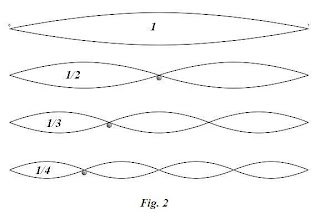Review of the Fundamental Physics:
(Acoustics of a String)
(Acoustics of a String)
The vibrations set adrift by a vibrating body in air are what we hear as sound. It may be your own voice or the guitar accompanying it. It’s all about “good vibes.”
The String Connection:
As you may remember from your high school books, when a string vibrates in a particular way, it produces a particular sound. These sounds are pure in the sense that have only one frequency and are called notes.
When a string vibrates it produces points along its length called nodes and internodes. Nodes are the points where the string moves the least and internodes are the places in between nodes (indicated by the arrows in Fig.1).

Thus the whole string vibrates in segments. The number of such segments depends on how the string has been pluck.
The fundamental frequency (F0 Hz) is produced when the string (Fig .1) vibrates as a whole (1). It is the frequency produced when the whole string vibrates as a loop between two nodes. Any note which is produced by the same vibrating string along side the fundamental frequency (and numerically greater than it) called an overtone or a partial. The string being flexible vibrates, at a time, in more than one way. As seen in Fig. 2, the string may vibrate in 1/2s, 1/3rds, 1/4ths, etc. Each (see below) fraction produces a partial. These are faint and masked by the fundamental though these are the sounds that give each instrument its distinctive flavor.
Frequency of the sound produced by “entire string” vibrating in a particular number of segments is given as a simple multiple of the fundamental frequency. The multiplying factor here is the number of internodes.
Thus, when a string is vibrating with n number of internodes, the frequency of sound (overtone) produced (Fn Hz) is given by:
Fn = F0 X n
Here Fn is called the harmonics of F0. In Fig.2 the string (1) vibrates in 2, 3 and 4 segments. Thus the Fn values will be 2 F0, 3F0, and 4F0 respectively.

The absolute value of the “fundamental frequency” produced by a vibrating string vibrating (i.e. only one internode between the two fixed ends – nodes) is given by:

Where F is the frequency of the sound, L is the length of the string, T is the tension (force of winding) on the string and m is the mass per unit length (how heavy the string is) of the string.
From this we can derive that, the frequency will be more (sound will be higher pitched or shriller) if:
(i) the string is shorter;
(ii) the string is more tensed (pulled more / wound more strongly);
(iii) if the string is of lighter or finer gauge or made up of lighter material.
Some basic terms in acoustics and music to be familiar with:
1. Note : A term denoting the relative duration and pitch of a sound.
2. Tone : A sound of a single frequency with no harmonics.
3. Fundamental Frequency (F) : Lowest frequency of a harmonic or an inharmonic series.
4. Pitch : Property of a sound or musical note measured by its perceived frequency.
5. Overtone / Partials / Partial tones : A multiple of the fundamental tone that is greater than it – may or may not be an integral multiple.
6. Harmonic : It is a frequency which is an exact integral multiple of the fundamental note (2F, 3F, 4F, 5F, etc.)
7. Inharmonic : It is that frequency of overtones that is not a whole multiple of the fundamental frequency.
8. Interval : Difference in frequencies between two notes or two different notes played together.
9. Octave (P8) : The note at an interval between one musical note and another with half or double its frequency. (If F=440Hz: 1 octave higher is 880Hz and an octave lower is 220Hz.)
10.Consonant: Smooth or pleasant sounding intervals.
11. Dissonant : Rough or unpleasant sounding intervals.
12.Node: A point along a standard wave (vibrating string) where it has minimal amplitude.
13.Internode : The segment of the vibrating string in between two adjacent nodes.
14.Amplitude : The amount that a string vibrates at a particular point. It is minimal at nodes and maximum at the mid-point of the intervening internode.
15.Wave : It is a disturbance that propagates through space and time, usually with transference of energy.
http://basicmusictheory.blogspot.com/2008/11/review-of-fundamental-physics-acoustics.html
Liked 'Fundamental Physics : Acoustics of a String' enough to share / save?
Comments: 0 comment(s)...have your say!
Post your comment!